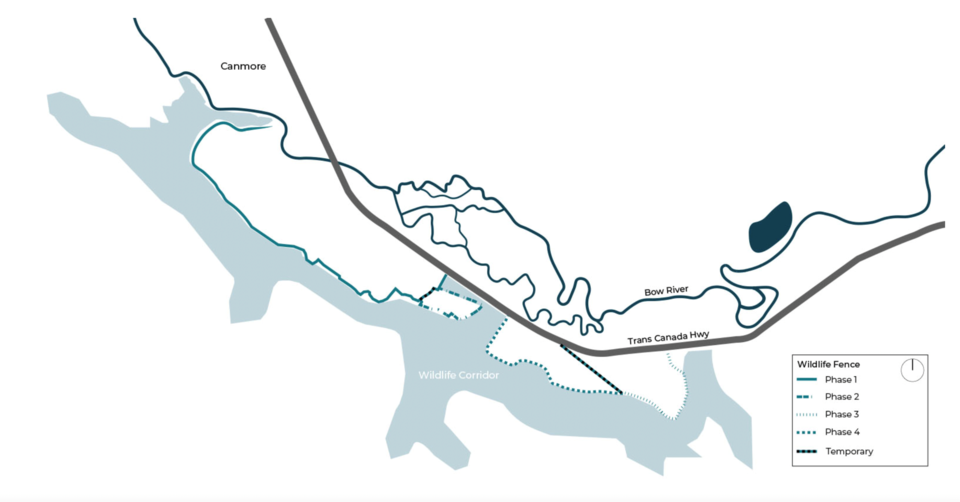CANMORE – Construction of a 2.4-metre high fence around Canmore’s Three Sisters Mountain Village lands to keep wildlife out of developed areas and people out of wildlife corridors has started.
The first stage of the wildlife fence will be about eight kilometres long, and will surround the areas of Stewart Creek, Three Sisters Ridge, Three Sisters Creek, Gateway at Three Sisters, Cairns on the Bow and Three Sisters Village. It also crosses through the Stewart Creek Golf Course.
“We are building that all at once, and at this moment in time, work is ongoing on the golf course,” said Jessica Karpat, director of planning and community liaison for Three Sisters Mountain Village Properties Limited (TSMVPL) at the Nov. 5 Canmore council meeting.
“For Smith Creek, it’s a different methodology, so we will commence the fence with Smith Creek phase 1 and we will only build the fence in phases, so that will leave habitat within the forest areas for the wildlife to roam until we are developing.”
The fence, which is part of the approval process for Three Sisters Village and Smith Creek developments, aims to delineate and separate wildlife and human use areas along the Three Sisters wildlife corridor system, and is the same type of fence used by Parks Canada along the Trans-Canada Highway in Banff and Yoho national parks.
It will connect to the fence along the Trans-Canada Highway where possible. There will also be wildlife jumpouts and trail gates at selected locations along the fence and a vehicle crossing – similar to a Texas gate – installed across Three Sisters Parkway to the west of Cairns on the Bow as a part of this work.
Access points to provincially designated trails will be facilitated through gated entry points.
TSMVPL is paying for the construction of the wildlife fence and the provincial government will own and maintain it.
Canmore council has unanimously passed an amendment to the land use bylaw to essentially reduce red tape. It exempts the construction and maintenance of a wildlife exclusion fence from requiring a development permit when the fence is required for an area redevelopment plan or area structure plan or under provincial jurisdiction.
“It allows for the implementation of something that’s needed to facilitate development within that plan area as a part of a series of approvals,” said Harry Shnider, the Town’s manager of planning and development.
Mayor Sean Krausert wanted to make sure council and the community could be confident construction of the fence would respect conservation easements and take into account the 35-metre buffer from the wildlife corridor outside the fence based on the process to date.
Shnider replied: “Without me looking at the nitty-gritty details of the plans, I do have confidence that these specifications and these setbacks are being respected because they are understood by everyone.”
Karpat said about 800 acres of the lands for the wildlife corridor, including the conservation easement, are all being transferred to provincial ownership, adding the community can be confident the “spirit of wildlife connectivity and movement will be maintained by the province.”
“We’ve always had issues with enforcement and who does the enforcement where because of the conservation easement,” she said.
“Being able to transfer these lands all into one ownership under the province also addresses some of these enforcement issues that we’ve encountered in the past.”
Krausert said while he had initial concerns about the placement of the fence, he was satisfied with the answers he was given.
“We can always also ask the question to make sure that they are in fact placed accordingly,” he said.
Coun. Tanya Foubert also spoke in favour of the amendment, noting requiring a development permit on provincially owned lands for this type of work is unnecessary.
“It is simply paperwork and it’s not something that increases accountability …” she said.
“The need for a development permit, it just doesn’t line up as the best use of anyone’s time or energy and because it’s strictly limited to provincially owned land.”




